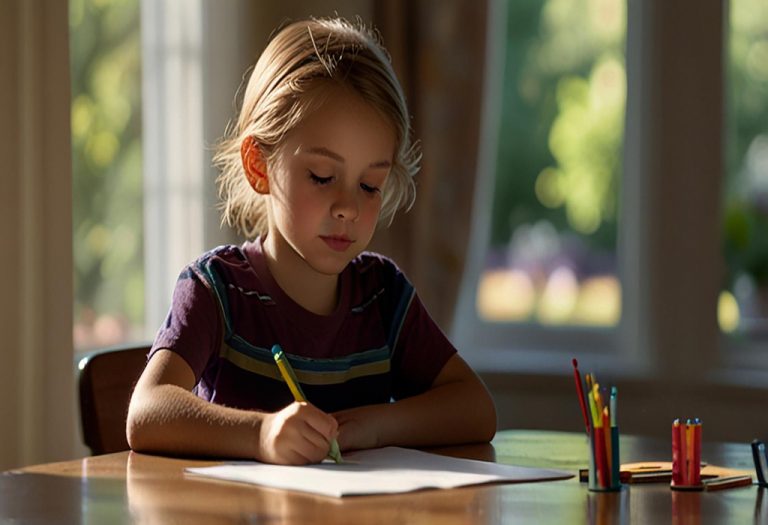Do this to improve your child's Creative Writing skills
Simple Ways to Make Writing Fun and Engaging for Kids

Creative writing is a fantastic way for children to express themselves, develop crucial skills, and have fun. A great way to nurture this in your child is by making it as fun as possible. This can be achieved by incorporating interactive and engaging activities into your child’s routine. In doing so, you can help them become more confident writers and enthusiastic storytellers.
Creative writing isn’t just about crafting stories—it’s a fun way for kids to explore their imaginations, learn new skills, and express themselves.
Here’s why creative writing is so valuable:
Boosts Imagination and Creativity
Creative writing lets kids dream up all kinds of worlds, characters, and adventures. It helps them think creatively and look at things from different perspectives.Improves Communication Skills
Writing stories will help your child learn how to express their thoughts and ideas clearly, which can also help them with speaking and listening.Builds Confidence
When children write and share their stories, they feel proud of their work. Seeing their ideas come to life on paper can boost their self-esteem and encourage them to keep writing.Develops Empathy
Writing from different characters’ points of view helps your child understand how others might feel, which can build empathy and social skills.Strengthens Literacy Skills
Regular writing helps children expand their vocabulary, improve grammar, and develop better reading and writing habits.Encourages Critical Thinking and Problem-Solving
Creating a story means figuring out what happens next, which can improve planning and problem-solving skills.
Fun Tips and Activities to Help Your Child with Creative Writing
Encourage Daily Writing Practice
Help your child make writing a daily habit by setting aside a specific time each day. It can be as short as 10 minutes. Use fun prompts to get them started.- Example: Ask them to write a story about “What would happen if my pet could talk for a day?” or “Imagine if you woke up one morning with superpowers—what would you do first?”
Create a Story Jar
Make a “Story Jar” filled with slips of paper containing different story ideas or character descriptions.- Example: Fill the jar with prompts like “A secret door in your school,” “A cat who thinks it’s a superhero,” or “A magical treehouse in the backyard.” Let your child pick one when they’re ready to write.
Read Regularly Together
Reading and writing go hand in hand. Make a habit of reading together daily. Discuss the stories you read to help your child learn about story structure, character development, and settings.- Example: After reading a story, ask questions like, “What would you do if you were the main character?” or “How would you change the ending?”
Use Visual Prompts
Show your child a picture and ask them to write a story based on what they see. Visual prompts can spark their imagination and give them a concrete starting point.- Example: Use a picture of a mysterious castle, a busy city street, or an unusual animal. Ask, “What’s happening in this picture? Who are the characters? What happens next?”
Play Word Games
Word games are a great way to build vocabulary and inspire creativity. Games like “Story Cubes,” “Mad Libs,” or even “Scrabble” can make learning new words fun.- Example: Use “Story Cubes” to roll different dice that show images, then make up a story based on the images that appear. It’s a fun, spontaneous way to think creatively!
Incorporate Creative Writing into Playtime
Use toys, action figures, or dolls to act out stories. Let your child narrate the actions and dialogue of their toys, turning playtime into a storytelling session.- Example: Ask your child to create a story with their toy dinosaurs or dolls—maybe they’re on a mission to find a hidden treasure or solving a mystery in their toy city.
Encourage Journaling
Give your child a special journal to write about their day, dreams, or feelings. Journaling is a relaxed way to practice writing regularly and helps kids express their thoughts freely.- Example: Prompt them with ideas like “Write about your favorite part of the day,” or “Draw and describe a dream you had last night.”
Organize a “Writing Club” with Friends
Create a small writing club where your child and their friends can meet regularly to write stories, share them, and give each other feedback.- Example: Set up a weekly “Writing Club” after school where kids can work on a group story, take turns adding a new chapter, or have a mini story competition with fun prizes.
Attend Storytelling Events or Workshops
Look for local events, workshops, or library programs that offer storytelling sessions or creative writing classes. These can provide inspiration and new techniques for writing.- Example: Sign up for a local library’s story hour or a creative writing workshop designed for kids. It’s a great way for them to learn from others and find new friends who love stories too!
Celebrate Their Writing
Make your child feel proud of their work by celebrating their stories. Display their writing on the fridge, create a special binder, or even publish their stories in a family “newsletter.”
- Example: Create a “Story of the Week” showcase at home where each week, a new story gets the spotlight. Read it together as a family and talk about your favorite parts!
Wrap-Up
Creative writing is a fantastic way for kids to learn and grow. By making it fun and engaging, you can help your child build essential skills and a lifelong love for storytelling. Remember, the key is to keep it enjoyable—let their imagination run wild, and who knows what amazing stories they’ll come up with!
Useful Links
Contact
hello@timelinetutorials.com 020348811957
Kinetic Business Centre, Borehamwood WD6 4PJ
Subscribe Now
Don’t miss our future updates! Get Subscribed Today!
©2024. Timeline Tutorials All Rights Reserved.